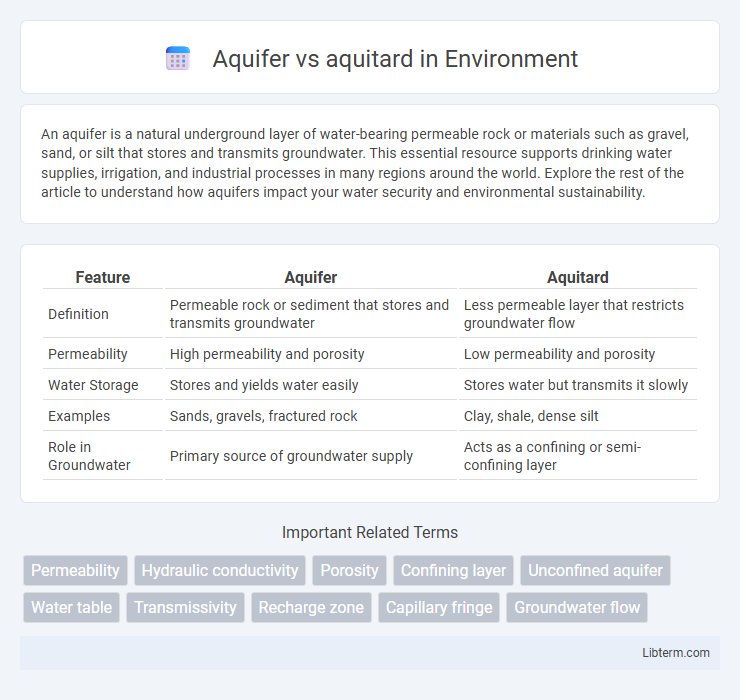An aquifer is a natural underground layer of water-bearing permeable rock or materials such as gravel, sand, or silt that stores and transmits groundwater. This essential resource supports drinking water supplies, irrigation, and industrial processes in many regions around the world. Explore the rest of the article to understand how aquifers impact your water security and environmental sustainability.
Table of Comparison
| Feature | Aquifer | Aquitard |
|---|---|---|
| Definition | Permeable rock or sediment that stores and transmits groundwater | Less permeable layer that restricts groundwater flow |
| Permeability | High permeability and porosity | Low permeability and porosity |
| Water Storage | Stores and yields water easily | Stores water but transmits it slowly |
| Examples | Sands, gravels, fractured rock | Clay, shale, dense silt |
| Role in Groundwater | Primary source of groundwater supply | Acts as a confining or semi-confining layer |
Introduction to Aquifers and Aquitards
Aquifers are permeable geological formations that store and transmit groundwater, characterized by high porosity and permeability. Aquitards, in contrast, are layers of low permeability material such as clay or shale that restrict groundwater flow between aquifers. Understanding the distinct properties of aquifers and aquitards is essential for effective groundwater management and hydrogeological assessments.
Definition of Aquifer
An aquifer is a geological formation composed of permeable materials such as sand, gravel, or fractured rock that can store and transmit significant quantities of groundwater. It serves as a vital natural reservoir, providing a sustainable source of water for wells, springs, and ecosystems. In contrast, an aquitard is a layer of less permeable material like clay or silt that restricts groundwater flow, acting as a barrier rather than a conduit.
Definition of Aquitard
An aquitard is a geological formation composed of layers of clay or dense rock that significantly restrict groundwater flow, acting as a barrier between permeable aquifers. Unlike aquifers, which store and transmit groundwater efficiently, aquitards impede water movement due to their low permeability. Understanding the role of aquitards is crucial for groundwater management and hydrogeological studies, as they influence the distribution and recharge of aquifers.
Key Differences Between Aquifer and Aquitard
Aquifers are permeable rock formations that store and transmit groundwater effectively, whereas aquitards are low-permeability layers that restrict water flow between aquifers. The primary difference lies in hydraulic conductivity: aquifers have high permeability, enabling water movement, while aquitards have minimal permeability, acting as barriers or confining layers. Aquifers supply usable groundwater resources, while aquitards influence the direction and pressure of groundwater flow but do not serve as significant water sources.
Types of Aquifers
Unconfined, confined, and perched aquifers represent the primary types of aquifers, each differing in geological characteristics and water storage capacity. An unconfined aquifer lies directly beneath the earth's surface with a permeable layer above, whereas a confined aquifer is trapped between impermeable layers, often leading to higher pressure and artesian wells. Aquitards are semi-permeable layers that restrict water flow between aquifers, playing a crucial role in controlling groundwater movement and storage in hydrogeological systems.
Types of Aquitards
Aquitards are geological formations that restrict groundwater flow between aquifers, typically composed of clay, silt, or unfractured shale with low permeability. Common types of aquitards include confining layers, which completely block water movement; semi-confining layers, which partially impede flow; and leaky confining layers, which allow limited water transfer due to fractures or increased permeability zones. Understanding the specific type of aquitard is crucial for groundwater management, contamination control, and hydrogeological modeling.
Role in Groundwater Movement
Aquifers are permeable geological formations that store and transmit groundwater efficiently, enabling sustainable water extraction. Aquitards consist of low-permeability materials such as clay or shale, restricting groundwater flow and acting as barriers that separate different aquifer layers. Their contrasting roles regulate groundwater movement, influencing aquifer recharge rates, water availability, and contaminant migration.
Importance in Water Supply and Management
Aquifers are critical groundwater reservoirs that store and transmit water efficiently, making them essential for sustainable water supply and management. Aquitards, composed of low-permeability materials, act as natural barriers that restrict water flow, helping to protect aquifers from contamination and control the movement of pollutants. Understanding the interaction between aquifers and aquitards is vital for developing effective groundwater extraction strategies and maintaining water quality in hydrogeological systems.
Common Examples and Locations
Aquifers commonly include the Ogallala Aquifer in the central United States, known for its extensive use in agriculture, and the Guarani Aquifer spanning parts of South America, valued for its large freshwater reserves. Aquitards typically consist of clay or shale layers like the Pierre Shale in the Western U.S., acting as barriers that limit water flow between aquifers. These geological formations are crucial for managing groundwater resources and understanding regional water availability in diverse locations worldwide.
Conclusion: Aquifer vs Aquitard in Hydrogeology
Aquifers are permeable geological formations that store and transmit groundwater, whereas aquitards are less permeable layers that restrict water flow. The distinction between aquifers and aquitards is critical for groundwater management, influencing water availability and contaminant migration. Effective hydrogeological assessments rely on accurately identifying these units to predict groundwater movement and resource sustainability.
Aquifer Infographic

 libterm.com
libterm.com